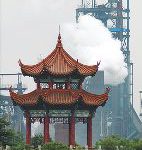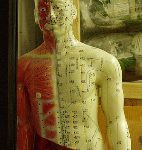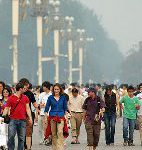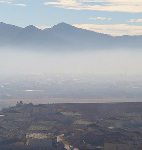At over three and a half kilometres above sea level, Lhasa is the world’s highest city. Many people decide to visit this enchanting place, known as the “holy city in the land of the snows”.
On July 1, 2006, the Qinghai-Tibet railway opened and crowds of people from China’s cities clambered aboard to visit the place they had dreamed of – including my friend, Tian.
Tian is a journalist with the Xinhua news agency, and had always wanted to visit Lhasa. At the end of August, Tian boarded the train to Tibet. But three days later he returned, deeply disappointed. Hotel prices had rocketed – a decent, reasonably-priced room was almost impossible to find. “And it was boring,” he added, “just the same as any Chinese city.” The tall buildings, congestion, noise and street hawkers had left his dream in ruins.
Nor is he the only one disappointed. A scientist friend from Peking University went to Lhasa in mid-August hoping to buy a Tibetan-style courtyard home – she imagined leaving behind the bustle of Beijing, sipping sweet Lhasa tea with a view of the Potala Palace. But Lhasa’s reality did not match up to her vision. Property prices had risen; the money which would previously have bought her a courtyard would only purchase a single room. Tall buildings crowded a skyline where once even four-storey structures were rare, blocking the view of Lhasa’s iconic Potala Palace.
In the seventh century, Songtsen Gampo unified Tibet and moved the centre of political power from Shannan to the site of present-day Lhasa – pastureland at the time — and founded the powerful, slave-owning Tubo Kingdom. He also built the Jokhang Temple, Ramoche Temple and the first Potala Palace. Legend has it that Songtsen Gampo used soil carried to the site by goats to build the Jokhang Temple and the city was thus named “Resa”, from the Tibetan words for soil (re) and goat (sa). With the adoption and rise of Buddhism, the number of pilgrims rose steadily. Hotels, shops, homes and administrative centers sprung up around the Jokhang Temple, forming the circular street known as the Barkhor. As Buddhism flourished, the Tibetan people started to call the city Lhasa, which means the “holy city” or “place of the Buddha”.
In the mid-17th century, the Qing emperor authorised the Fifth Dalai Lama, Lobsang Gyatso, to consolidate his political and religious power, with Lhasa as the centre of government. The Potala Palace was rebuilt to a height of thirteen storeys – almost 120 metres — and became the residence of the Dalai Lamas, seat of their political and religious rule and a landmark on the Lhasa skyline.
The Potala Palace makes a great visual impact as you first arrive. In 1936, F. Spencer Chapman, a member of the British Government’s mission to Lhasa, wrote in Lhasa, The Holy City: “Unlike any other building in the world, the Potala has the presence of a New York skyscraper and a subtle similarity to the Pyramids of Egypt…not only are the design and color of the building breath-taking in their beauty, it is also of enormous size. This majestic beauty can best be appreciated in the government park below the Potala.” But for Tibetans, the Potala’s impact is not merely visual. Karma, from Tibet’s Chamdo region, told me of how he wept and prayed when he first glimpsed the Potala. Many Tibetans have similar tales to tell. For them the Potala is not just a building, it is the home of their faith – and it is this which makes Lhasa holy.
It was in the 17th century that Lhasa first started to evolve into a city. Official residences, mansions, guesthouses and shops were built flanking the Barkhor, but on a small scale. As late as 1906, there was only a small residential area near the Jokhang. The city had expanded by 1935, when the “Snow Village” residential district was built in front of the Potala. But by 1950, Lhasa still had a population of only 30,000 and covered less than three square kilometres, with dirt roads and no sewers.
It was later that the process of urbanisation really started to take hold. By 1975, Lhasa covered 18 square kilometres and had a population of 100,000. According to statistics from the city government’s website, Lhasa is now 18 times the size it was in 1959, with a quarter of a million people living in the urban area (100,000 of those migrants). Locals have told me that since the opening of the railway and the arrival of many more wealthy people, the actual population has already risen far beyond that figure.
Some examples may help to illustrate the changes in the city. For instance, when Chapman visited Lhasa 70 years ago, he described seeing women dumping all kinds of rubbish in front of the Potala, forming 10-foot-high piles by the roadside. When I visited in May, the Potala was fronted by a huge, clean plaza.
But before 1959, the Potala was a solemn and sacred place. Now it is a tourist attraction. Another friend of mine from Beijing took the train to Lhasa in July. When she set foot in the Potala it wasn’t the architecture, the culture or the history that struck her – it was the hordes of tourists streaming like termites over the wooden floors. Previously, visitor numbers were limited to 850 a day in order to protect the building, but this number was raised to 1,500, and then to 2,300 visitors a day once the railway was opened – earning huge amounts of money for the Potala’s managers.
Today it is still the sight of the Potala Palace, perched on top of the Red Mountain, which heralds the traveller’s arrival in Lhasa. But as you get closer to the city it becomes lost behind modern buildings. Buildings and roads named after places in northern and eastern China roll past – Jiangsu Road, Beijing Road, Shanghai Plaza and Shangdong Mansion. You may find yourself asking whether you are in Lhasa at all.
Once a “holy city” of unique tradition, Lhasa is undergoing huge and very complex changes – some bad and some good.
The author: Liu Jianqiang,born in 1969, is a senior reporter with Southern Weekend and has a long-standing interest in environmental issues.
Homepage photo by Christophe Polus



